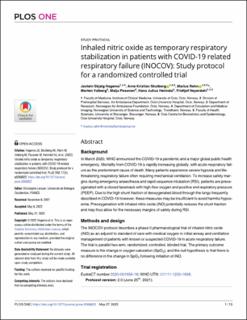| dc.contributor.author | Hagemo, Jostein Skjalg | |
| dc.contributor.author | Skulberg, Arne Kristian | |
| dc.contributor.author | Rehn, Marius | |
| dc.contributor.author | Valberg, Morten | |
| dc.contributor.author | Pesonen, Maiju | |
| dc.contributor.author | Heimdal, Hans Julius | |
| dc.contributor.author | Heyerdahl, Fridtjof | |
| dc.date.accessioned | 2023-04-03T11:33:35Z | |
| dc.date.available | 2023-04-03T11:33:35Z | |
| dc.date.created | 2022-09-01T13:14:48Z | |
| dc.date.issued | 2022 | |
| dc.identifier.citation | Hagemo, J.S., Skulberg, A.K., Rehn, M., Valberg, M., Pesonen, M., Heimdal, H.J., & Heyerdahl, F. (2022). Inhaled nitric oxide as temporary respiratory stabilization in patients with COVID-19 related respiratory failure (INOCOV): Study protocol for a randomized controlled trial. PLoS ONE, 17. | en_US |
| dc.identifier.issn | 1932-6203 | |
| dc.identifier.uri | https://hdl.handle.net/11250/3061796 | |
| dc.description.abstract | Background
In March 2020, WHO announced the COVID-19 a pandemic and a major global public health emergency. Mortality from COVID-19 is rapidly increasing globally, with acute respiratory failure as the predominant cause of death. Many patients experience severe hypoxia and life-threatening respiratory failure often requiring mechanical ventilation. To increase safety margins during emergency anaesthesia and rapid sequence intubation (RSI), patients are preoxygenated with a closed facemask with high-flow oxygen and positive end-expiratory pressure (PEEP). Due to the high shunt fraction of deoxygenated blood through the lungs frequently described in COVID-19 however, these measures may be insufficient to avoid harmful hypoxemia. Preoxygenation with inhaled nitric oxide (iNO) potentially reduces the shunt fraction and may thus allow for the necessary margins of safety during RSI.
Methods and design
The INOCOV protocol describes a phase II pharmacological trial of inhaled nitric oxide (iNO) as an adjunct to standard of care with medical oxygen in initial airway and ventilation management of patients with known or suspected COVID-19 in acute respiratory failure. The trial is parallel two-arm, randomized, controlled, blinded trial. The primary outcome measure is the change in oxygen saturation (SpO2), and the null hypothesis is that there is no difference in the change in SpO2 following initiation of iNO. | en_US |
| dc.language.iso | eng | en_US |
| dc.publisher | PLOS | en_US |
| dc.rights | Navngivelse 4.0 Internasjonal | * |
| dc.rights.uri | http://creativecommons.org/licenses/by/4.0/deed.no | * |
| dc.title | Inhaled nitric oxide as temporary respiratory stabilization in patients with COVID-19 related respiratory failure (INOCOV): Study protocol for a randomized controlled trial | en_US |
| dc.type | Peer reviewed | en_US |
| dc.type | Journal article | en_US |
| dc.description.version | publishedVersion | en_US |
| dc.rights.holder | The authors | en_US |
| dc.subject.nsi | VDP::Medisinske Fag: 700 | en_US |
| dc.source.volume | 17 | en_US |
| dc.source.journal | PLOS ONE | en_US |
| dc.source.issue | 5 | en_US |
| dc.identifier.doi | 10.1371/journal.pone.0268822 | |
| dc.identifier.cristin | 2047881 | |
| cristin.ispublished | true | |
| cristin.fulltext | original | |
| cristin.qualitycode | 1 | |

